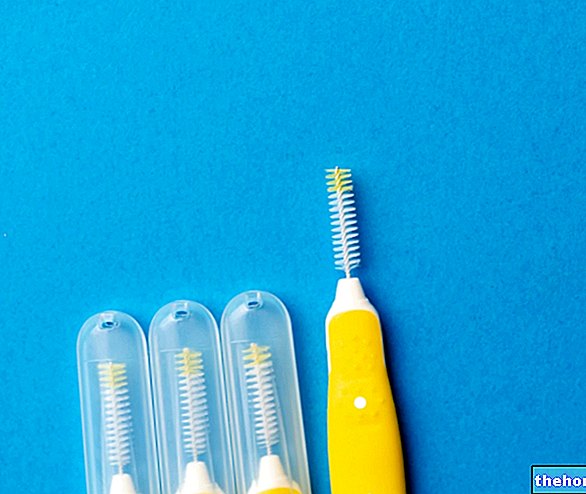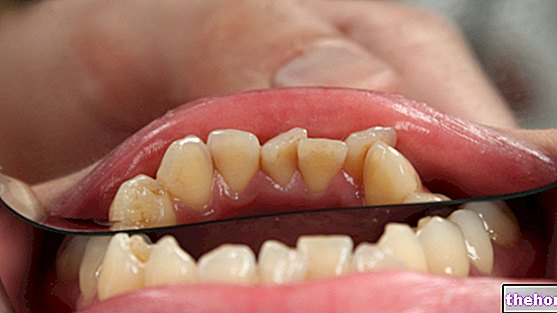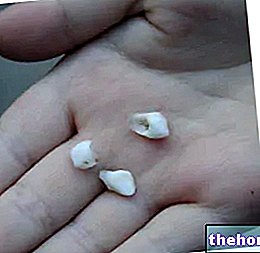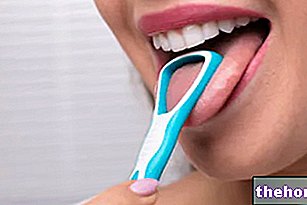Aesthetic veneers
Dental veneers (veneers) are special prostheses applied directly on the single tooth to improve its aesthetic appearance. These are very thin porcelain, ceramic or resin lamellae that are permanently cemented on the tooth, to correct small imperfections such as chipping, slightly crooked teeth, diastemas and yellow teeth or teeth disfigured by stains that cannot be treated by scaling or professional whitening.

Intervention
The so-called "restoration" through the application of ceramic or porcelain dental veneers requires both a specific preventive programming and the intervention of the dental technician.
Generally, the application of the most precious dental veneers requires two sessions at the dentist:
- The first phase involves the filing of the tooth, the execution of the dental impression and the choice of the most suitable color for the veneer;
- The second phase consists in the application of the veneer on the tooth (s).
Fundamental stages of the intervention:
- Control visit
- Tooth filing
- Dental impression
- Choice of shade for the dental veneer
- Tooth treatment with hydrofluoric acid and silane
- Cementation of the veneer on the tooth
- Polishing of the dental veneer
FIRST SESSION
First of all it is essential to "prepare" the tooth for the operation: this first step, which is very important, involves filing a part of the dental enamel. The amount of enamel to be removed must be equal to the thickness of the dental veneer that will be cemented into it: the purpose is to facilitate the fixing of the veneer permanently and safely, minimizing the risk of detachment.
This operation can be performed with or without local anesthesia (with lidocaine injection): very often the anesthetic is not necessary because the discomfort perceived during tooth filing is more than bearable. However, to reassure the patient, many doctors prefer to lightly numb the tooth with a minimal dose of anesthetic.
After the tooth has been filed, the doctor proceeds by making the patient's dental impression, which is essential to prepare a model on which to study the perfect size of the teeth.
At this point, with the help of a colorimetric scale, the dentist chooses the most appropriate veneer color for the patient: the prosthesis, in fact, must have the same color as the other teeth because it would not make sense to apply a shiny and candid veneer on yellow or stained teeth.
SECOND SESSION
The second session involves the application of the aesthetic veneer on the tooth. Before "gluing" it, the prosthesis must be tested directly on the patient, in order to ascertain that color and size are those required. If not, the veneer can be retouched or modified first to be fixed definitively.
- After cementation, no changes or color corrections to the ceramic veneer are possible.
The cementation phase is therefore carried out later, when the dental veneers are ready. This stage is extremely delicate because it requires the use of composite cements and adhesive systems; moreover, the tooth to be restored must be perfectly isolated with a dam, a small latex handkerchief which, fixed on a tooth, prevents the accumulation of saliva. and separates it from the other teeth.
Before cementing the veneer, the tooth must be treated with hydrofluoric acid and covered with a special adhesive (silane): this intermediate step is essential to obtain good adhesion to enamel and dentin using the composite cement. At this point, we can proceed with the cementation of the veneer on the tooth.
After the placement of the dental veneer, the prosthesis can be slightly smoothed (without making major modifications) with discs, burs and rubber pads to define its margins.
Maintenance
Taking care of teeth restored with dental veneers does not require special attention, especially if the cemented lamellae are porcelain or ceramic.
To maintain the structural integrity of these prostheses as long as possible, it is sufficient to follow some general rules:
- Avoid chewing hard or crunchy foods such as nougat, ice and hard candies: to avoid chipping the ceramic with which the veneer is made, the advice is to pay particular attention when chewing food. Although porcelain veneers are very resistant, resin veneers have the disadvantage of scratching and cracking much more easily. If this happens, the patient will have to undergo a retreatment.
- For the same reason explained above, it is advisable to eventually abandon the habit of biting your nails or gnawing pens and pencils.
- Regularly perform multi-daily dental cleaning even on teeth restored with dental veneers, in order to prevent the deposit of plaque and tartar. It is therefore recommended to use a toothbrush and toothpaste after meals and to complete interdental cleaning (with brush or dental floss) at least once a day. We remember, in fact, that dental infections (caries, in particular) can also affect the restored tooth: more precisely, the infection can affect the tooth in a portion that has not been treated with the veneer (caries cannot infect porcelain, resin and ceramic).
- To prevent dental infections, professional dental cleaning is recommended once every 6-12 months.
- For those suffering from bruxism (involuntary grinding of the teeth), the danger of ruining the dental veneers is quite high: to protect the surface of the teeth, it is recommended to use specific remedies (bite). Before undergoing restorative surgery with veneers, it is important to always tell your doctor if you suffer from bruxism: some dentists advise against these restorations because they would require retreatment 5-10 years after the operation.
- For fans of violent sports, it is strongly recommended to always protect teeth (both those restored with veneers and natural ones) with specific protections to prevent punches or blows on the teeth from traumatizing teeth and veneers.
- Do not smoke: the bad smoking habit can stain both the restored teeth with veneers, and affect the natural teeth.
- Pay attention to the intake of drinks and foods that can stain the teeth: in this regard, it is advisable to limit the consumption of tea, coffee and wine to avoid damaging the color of the dental veneers.




























